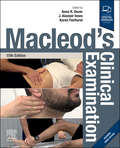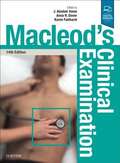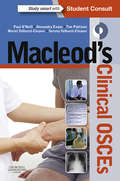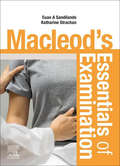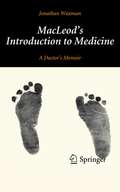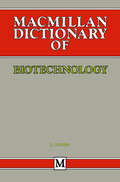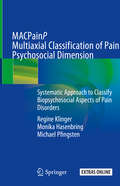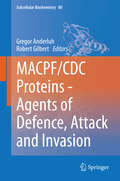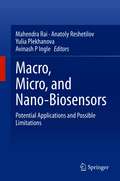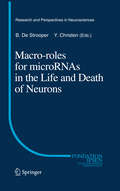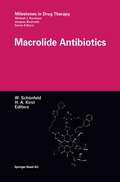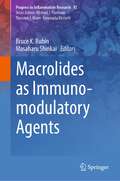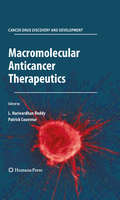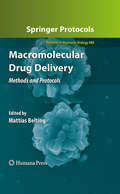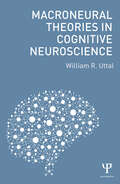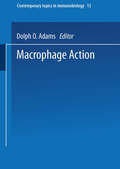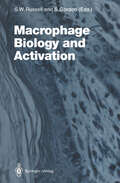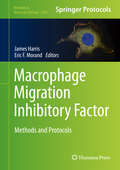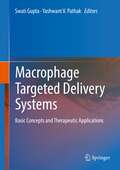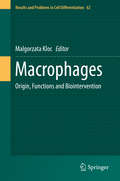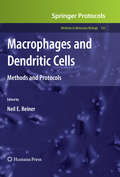- Table View
- List View
Macleod's Clinical Examination - E-Book: Macleod's Clinical Examination - E-Book
by J. Alastair Innes Karen Fairhurst Anna R DoverFifty years since it was first published and now fully revised, Macleod’s remains the textbook of choice for medical students, junior doctors, nurses and allied health practitioners who understand that excellence in clinical examination is integral to good practice. The fifteenth edition will teach you how to take a history and carry out proficient clinical examination, in order to elicit the key clinical symptoms and signs of disease. It covers general principles, relevant history, examination and investigations for all the major body systems – and how to effectively apply these skills to specific clinical situations and prepare for assessment. Macleod’s Clinical Examination is enhanced with 32 supplementary videos demonstrating key clinical examination routines described in the book, many new and revised for this edition in line with latest guidance and best practice. Primarily focused on the practical skills required by medical students and early career stage clinicians Explains the physical basis of clinical signs to aid understanding Introduces the formulation of a differential diagnosis Provides logical initial investigations for each body system Enhanced sections on adapting skills to particular situations, including the challenges of remote consultation and infection control Updated text and images, to ensure the content is relevant to a diverse readership and patient population Latest clinical decision-making models to aid the learner’s diagnostic reasoning 8 brand new videos produced especially for this edition covering: Obstetric examination Gynaecological examination Assessment of fluid balance Examination of the hand and wrist Examination of the foot and ankle Examination of the neck Examination of the foot in diabetes and peripheral vascular disease The timed up and go test
Macleod's Clinical Examination (PDF)
by J. Alastair Innes Anna R. Dover Karen FairhurstThis classic textbook aims to assist clinicians develop the consultation skills required to elicit a clear history, and the practical skills needed to detect clinical signs of disease. Where possible, the physical basis of clinical signs is explained to aid understanding. Formulation of a differential diagnosis from the information gained is introduced, and the logical initial investigations are included for each system.
Macleod's Clinical OSCEs - E-book
by Paul A. O'Neill Alexandra Evans Tim Pattison Meriel Tolhurst-Cleaver Serena Tolhurst-CleaverThis new book for medical students contains over 60 of the most commonly encountered OSCE stations in medicine and surgery. The OSCEs are arranged according to type of skill; for example history-taking, ethics and communication, physical examination. This is an accessible book for students under pressure who are revising for a clinical OSCE. It provides simple advice, tips about preparation, and will be easily understood. It provides sample OSCE station questions and simulated patient scripts (with answers) for practice at home.Provides sample OSCE station questions and simulated patient scripts (with answers) for practice at home. Will give an insight into how to ‘Get inside the examiners head’ to help the student do better in the OSCE station. Highlights ‘red flag’ situations and explains the underlying importance of these topics. Includes advice both on how to excel and on common errors at each OSCE station. Several of the OSCE stations give details of how more advanced students would be expected to perform at higher levels. Includes online access to sample marking sheets.
Macleod's Essentials of Examination E-Book
by Euan Sandilands Katharine Fiona StrachanThis new book is a companion to the international best-seller Macleod’s Clinical Examination. It places the examination of a patient in the context of how a student’s knowledge will be assessed in an OSCE or other form of clinical test. Using a standardised form of presentation this book will help the student succeed in passing their clinical tests.The book provides a standardised framework for examination of all the major body systems. Using a novel tabular approach the book provides a clear set of guidelines on what to do at each stage of the clinical examination. It also reminds the reader what are the corresponding key points to think about and sets out associated exam tips. The exam tips are subsequently linked to potential examiner’s questions. Each system ends with a reminder of how to present the findings and relevant tips to maximise your success.
MacLeod's Introduction to Medicine: A Doctor’s Memoir
by Jonathan Waxman‘MacLeod's Introduction to Medicine: A Doctor’s Memoir’ is a collection of stories that gives the reader an insight into the humorous side of a doctor's life. There is a rich source of humor in medicine, and this book aims to share some of this.
MACPainP Multiaxial Classification of Pain Psychosocial Dimension: Systematic Approach to Classify Biopsychosocial Aspects of Pain Disorders
by Regine Klinger Monika Hasenbring Michael PfingstenThis book offers a diagnostic tool for physicians and psychologists who want to systematically document pain within a multimodal structure. MACPainP (multiaxial classification of pain-psychosocial dimension) is a systematic, comprehensive and clinically oriented diagnostic instrument for evaluating pain-related disorders, and includes differentiated descriptions to enable syndromes to be systematized and diagnoses compared. MACPainP can be used as a professional add-on for the International Classification of Diseases ICD-10 as well as the upcoming pain classification ICD-11, released by WHO. This clearly structured book provides an easy introduction to the biopsychological aspects of pain disorders, to allow a nuanced approach to the psychological diagnosis of pain patients. It discusses possible comorbidities (e.g. depressive disorders, anxiety disorders) as well as concrete behavior-related steps for pain-related psychological and medical treatments. An essential reference for physicians and psychologists in the field of pain therapy, it is part of the learning European Pain Federation Curriculum (EFIC) of pain therapists.
MACPF/CDC Proteins - Agents of Defence, Attack and Invasion (Subcellular Biochemistry #80)
by Gregor Anderluh Robert GilbertThis book focusses on evolutionary, structural and functional aspects of pore-forming proteins, bringing together prominent researchers in the fields of structural biology and cellular and biophysical techniques. The focus is on the MACPF/CDC protein super family that was originally discovered because of unexpected structural similarity between a domain present in bacterial cholesterol-dependent cytolysins (CDC) and proteins of the membrane attack complex/perforin (MACPF) family. Members of the MACPF/CDC super family are crucial for many biological processes, being efficient agents of development, defence, attack and invasion of cells and tissues. However, their best-known role is in bacterial pathogenesis and the proper functioning of the vertebrate immune system, via formation of transmembrane pores in target cell membranes.The book contains chapters on the distribution of MACPF/CDC proteins and on aspects of their evolution and structural properties, the similarities between different super family members and functional properties of some of the best known examples. The book also contains an overview of biophysical approaches that may be used in the future to provide further insights into how these interesting proteins function.
Macro, Micro, and Nano-Biosensors: Potential Applications and Possible Limitations
by Mahendra Rai Anatoly Reshetilov Yulia Plekhanova Avinash P. IngleThis book includes an international group of researchers who present the latest achievements in the field of enzyme, immune system, and microbial and nano-biosensors. It highlights the experimental evidence for formation of biological fuel cells (BFCs)-which has a dual purpose – as a device that produces electricity and the systems which produce it simultaneously cleaning up the environment from polluting organic compounds. Considering the work in the field of macro, micro and nano-biosensors, considerable attention is paid to the use of nanomaterials for the modification of working electrodes. Nanomaterials in some cases can significantly improve the parameters of analytical systems. Readers will be interested in the projection of the presented theoretical and experimental materials in the field of practical application of modern analytical developments. The presented results in many cases imply the possibility of using the created models of macro, micro and nano-biosensors, and biofuel elements in the field of health, and protection/restoration of the environment. It includes information about all existing types of transducers of signals in biosensors – electrochemical, optical and quantum-optics, thermoelectric, data of atomic force microscopy, piezoelectric, and more. On the basis of these principles, descriptions are given about the functioning of macro, micro and nano- biosensors for the detection of compounds used in medicine, detection of compounds that clog the environment, and thus affect human health, for compounds that are potentially the basis for the production of drugs, for the selection of compounds that have medicinal activity, for immunodetection, and to assess the quality of food. These questions form the basis of research carried out in the field of biosensors in the world. Since the described models of biosensors have high sensitivity, high measurement speed and selectivity, the described results attract the attention of both the ordinary reader and business class specialists who create and implement analytical technologies. This book is very useful for researchers in life sciences, chemical sciences, physics, and engineering. In addition, it will be useful for the persons working in industry. Advanced technologies specialists will be attracted by the novelty of the proposed solutions and their relevance and ease of implementation. Since the studies contain sections describing the parameters of different biosensors, BFCs, they are easily navigated into assessing the effectiveness of the practical use of the proposed device. The relevant sections indicate such characteristics as detection ranges, life span, type of biological material used, the method of formation of the bio-receptor part. These parameters are of interest to both developers of new models of biosensors and BFC, and their manufacturers.
Macro Roles for MicroRNAs in the Life and Death of Neurons (Research and Perspectives in Neurosciences)
by Bart De Strooper Yves ChristenThe discovery of microRNAs has revealed an additional level of fine tuning of the genome and how genes are used again and again in different combinations to generate the complexity that underlies for instance the brain. This book examines this field.
Macrolide Antibiotics (Milestones in Drug Therapy)
by Wolfgang Schönfeld Herbert A. KirstThere are only very few chemical classes of antibiotics in medical use, and these have originated over a span of more than 60 years of research. Almost half a century ago, the first member of the macrolides, erythromycin, was introduced as a treatment option for bacterial infections. Erythromycin is a very complex fermentation product obtained from the soil bacterium Saccharopolyspora ery thraea (originally named Streptomyces erythreus). The success of erythromycin, based on its efficacy and tolerability, stimulated researchers throughout the world to undertake intense efforts to understand the biology and chemistry of macrolides and to use this experience to improve the properties of this compound class. The second generation of macrolides, based on chemical modifications of erythromy cin, is currently being in broad use, especially for treatment of respiratory tract infections. We presently foresee the introduction of a new generation of macro lides, i. e. the ketolides, which have the potential to overcome rising resistance problems. This monograph is intended to give the interested reader an overview on "macrolide experience", covering important areas from basic research to clinical use. Starting from a historic overview, the essential basic parameters - efficacy, pharmacokinetics, pharmacodynamics, and pharmacology - are highlighted in order to introduce the reader to the rationale for clinical use of macrolides. The following group of chapters cover the complex chemistry of the macro lactone structures, giving historic background, basic structure-activity relation ships of various derivatization strategies, and perspectives for future discovery of new semisynthetic macrolide antibiotics.
Macrolides as Immunomodulatory Agents (Progress in Inflammation Research #92)
by Bruce K. Rubin Masaharu ShinkaiFor over 50 years, clinicians have known that macrolide antibiotics have effects on inflammation and the immune system that are not related to their antimicrobial properties. These immunomodulatory properties, best described for treating inflammatory airway diseases, protect the lung and the host and improve clinical status. This book summarizes our current knowledge regarding proposed mechanisms for these properties, established clinical results, and what the future may hold with emphasis on novel clinical applications and the fascinating development of non-antimicrobial macrolides with preserved and enhanced immunomodulatory properties.
Macromolecular Anticancer Therapeutics: Macromolecular Anticancer Therapeutics (Cancer Drug Discovery and Development)
by L. Harivardhan Reddy Patrick CouvreurIn spite of the development of various anticancer drugs, the therapy of cancer has remained challenging for decades. The current therapy of cancer is overwhelmed because of the inability to deliver therapeutics to all regions of a tumor in effective therapeutic concentrations, intrinsic or acquired resistance to the treatment with currently available agents via genetic and epigenetic mechanisms, and toxicity. As a result, cancer therapy using conventional therapeutics and different types of treatment regimens using this therapeutics has not led to a convincing survival benefit of the patients. In this context, Macromolecular therapeutics offer several advantages over conventional low molecular therapeutics by various ways such as, enable the use of larger doses of these agents by limiting the toxicity, by enhanced permeability and retention into tumors, by tumor targeting using tumor-specific antibodies, by specific inhibition of oncogenes using anticancer oligonucleotides etc. Cancer treatment using this macromolecular therapeutics has considerably improved the survival benefit for patients. As a result, various macromolecular therapeutics are already commercialized or are under clinical development. Although we are far from a real magic bullet today, looking at the pace of research and current success in this field of macromolecular therapeutics, it appears that we are approaching a magic bullet for the efficient treatment of cancer. Thus, we believe that the subject of this book is very timely, and that the book will fill an unmet need in the market. This book is unique and assembles various types and aspects of macromolecular anticancer therapeutics for cancer therapy in one shell and conveys the importance of this interdisciplinary field to the broad audience. Thus, in a nutshell, this book details the basics of cancer, and various therapeutic strategies such as those based on macromolecular therapeutics hence can become an important reference for practitioners, oncologists, medical pharmacologists, medicinal chemists, biomedical scientists, experimental pharmacologists, pharmaceutical technologists, and particularly it can essentially become a handbook of macromolecular therapeutics for cancer therapy for graduates, post-graduates and Ph.D. students in these fields.
Macromolecular Drug Delivery: Methods and Protocols (Methods in Molecular Biology #480)
by Mattias BeltingMacromolecular drugs hold the promise of becoming new therapeutics for several major disorders, including cancer and cardiovascular disease. This incredible potential is explored in Macromolecular Drug Delivery, a volume which gives a wide-ranging overview of contemporary methods used in the field, and which addresses the limitations presented by a lack of safe and efficient drug delivery strategies. Chapters offer information on both in vitro and in vivo methods of macromolecular delivery, thus appealing to a broad scientific audience. Composed in the highly successful Methods in Molecular Biology™ series format, each chapter contains a brief introduction, step-by-step methods, a list of necessary materials, and a Notes section which shares tips on troubleshooting and avoiding known pitfalls. Comprehensive and cutting-edge, Macromolecular Drug Delivery offers a platform for interdisciplinary collaboration, which should provide opportunities for new discoveries at the interface between disciplines. Ultimately, this cooperation will lead to the use of macromolecular drugs as novel diagnostic tools and, even more importantly, as a means to revolutionize the way we view and treat diseases.
Macroneural Theories in Cognitive Neuroscience
by William R. UttalIn this book, William R. Uttal continues his analysis and critique of theories of mind. This book considers theories that are based on macroneural responses (such as those obtained from fMRI) that represent the averaged or cumulative responses of many neurons. The analysis is carried out with special emphasis on the logical and conceptual difficulties in developing a theory but with special attention to some of the current attempts to go from these cumulative responses to explanations of the grand question of how the mind is generated by the brain. While acknowledging the importance of these macroneural techniques in the study of the anatomy and physiology of the brain, Uttal concludes that this macroneural approach is not likely to produce a valid neural theory of cognition because the critical information—the states of the individual neurons—involved in brain activity becoming mental activity is actually lost in the process of summation. Controversial topics are considered in detail including discussions of empirical, logical, and technological barriers to theory building in cognitive neuroscience.
Macroneural Theories in Cognitive Neuroscience
by William R. UttalIn this book, William R. Uttal continues his analysis and critique of theories of mind. This book considers theories that are based on macroneural responses (such as those obtained from fMRI) that represent the averaged or cumulative responses of many neurons. The analysis is carried out with special emphasis on the logical and conceptual difficulties in developing a theory but with special attention to some of the current attempts to go from these cumulative responses to explanations of the grand question of how the mind is generated by the brain. While acknowledging the importance of these macroneural techniques in the study of the anatomy and physiology of the brain, Uttal concludes that this macroneural approach is not likely to produce a valid neural theory of cognition because the critical information—the states of the individual neurons—involved in brain activity becoming mental activity is actually lost in the process of summation. Controversial topics are considered in detail including discussions of empirical, logical, and technological barriers to theory building in cognitive neuroscience.
The Macrophage as Therapeutic Target (Handbook of Experimental Pharmacology #158)
by Siamon GordonDuring the past decade, the rapid growth of molecular and cellular knowledge of macrophages, as a specialized host defense and homeostatic system, has begun to offer attractive targets for therapeutic intervention. Macrophages play a central role in a wide range of disease processes, from genetically determined lysosomal storage diseases, to acute sepsis, chronic inflammation and repair, tissue injury and cell death. Under- or overactivity of macrophage clearance, immune effector functions and responses to metabolic abnormalities contribute to common disorders such as autoimmunity, atherosclerosis, Alzheimer’s disease and major infections including AIDS and Tuberculosis. Whilst the goals of therapeutic intervention based on improved understanding of macrophage functions and their contribution to pathogenesis may seem self evident, there are considerable difficulties in producing useful new agents. The present volume covers a range of subjects and provides opportunities for a more focused macrophage-targeted approach. The individual chapters review selected topics briefly, to place cellular processes and molecular targets in perspective. Overall, the volume should provide a broad sample of the state of the art. Useful reviews and references in the literature are cited within individual chapters.
Macrophage Biology and Activation (Current Topics in Microbiology and Immunology #181)
by Stephen W. Russell Siamon GordonThe amazing world of the mononuclear phagocytes keeps expanding at a truly awesome pace. As a result, maintaining currency with the latest developments and controversies that pertain to this cell type is increasingly difficult. The aspects covered in this volume have been selected to provide an overview of subject areas that either have recently become much better understood or hold the promise of new levels of understanding as they are developed in the future. The scope of topics ranges from how these cells develop, through the means that are used to regulate them, to the roles that they have in different tissues and in a variety of infectious diseases.
Macrophage Migration Inhibitory Factor: Methods and Protocols (Methods in Molecular Biology #2080)
by James Harris Eric F. MorandThis volume looks at--and discusses the techniques of--a range of areas in biology in which macrophage migration inhibitory factor (MIF) is studied. Topics covered in this book include methods to quantify MIF in cell supernatants and human samples, using ELISA and western blot; detection and analysis of intracellular MIF using flow cytometry; genotyping of human MIF polymorphisms, detection of MIF expression in a marine invertebrate using rapid amplification of cDNA RACE; studying the MIF receptor CD74 in tissues using immunohistochemistry; and studying MIF in models of disease such as asthma, Plasmodium infection, and gout. Written in the highly successful Methods in Molecular Biology series format, chapters include introductions to their respective topics, lists of the necessary materials and reagents, step-by-step, readily reproducible laboratory protocols, and tips on troubleshooting and avoiding known pitfalls. Comprehensive and practical, Macrophage Migration Inhibitory Factor: Methods and Protocols is a valuable resource that will help researchers gain a new understanding of MIF biology in health and disease.
Macrophage Targeted Delivery Systems: Basic Concepts and Therapeutic Applications
by Yashwant V. Pathak Swati GuptaThe proposed book is envisioned for the nascent and entry-level researchers who are interested to work in the field of drug delivery and its applications specifically for macrophage targeting. Macrophages have gained substantial attention as therapeutic targets for drug delivery considering their major role in health and regulation of diseases. Macrophage-targeted therapeutics have now added significant value to the lives and quality of life of patients, without undue adverse effects in multiple disease settings. We anticipate examining and integrating the role of macrophages in the instigation and advancement of various diseases. The major focus of the book is on recent advancements in various targeting strategies using delivery systems or nanocarriers followed by application of these nanocarriers for the treatment of macrophage associated disorders. Macrophage Targeted Delivery Systems is primarily targeted to Pharmaceutical Industry & Academia, Medical & Pharmaceutical Professionals, Undergraduate & Post graduate students and Research Scholars, Ph.D, post docs working in the field of medical and pharmaceutical sciences.
Macrophages: Origin, Functions and Biointervention (Results and Problems in Cell Differentiation #62)
by Malgorzata KlocThis volume gives a state-of-the-art overview on macrophage functions in various invertebrate and vertebrate systems and diseases. It also covers various aspects of macrophage development and formation, behavior and response to nano- and biomaterials, the latter of which have become very important components of modern medicine. Macrophages are evolutionarily conserved phagocytotic cells. In recent years macrophages have emerged as one of the most versatile cells of immune system, which, depending on the milieu and circumstance, participate in development or inhibition of cancer, regeneration, wound healing, inflammation, organ rejection and interaction between mother and a fetus. This book will be of particular interest to researchers working in immunology, cancer research, developmental biology, or related fields.
Macrophages and Dendritic Cells: Methods and Protocols (Methods in Molecular Biology #531)
by Neil E. ReinerIn light of the critical contributions of macrophages and dendritic cells to diverse inflammatory diseases and to immunity and host defense, state-of-the-art approaches to the investigation of their behavior are essential. In Macrophages and Dendritic Cells: Methods and Protocols, expert researchers contribute laboratory protocols involving these two vital cell types functioning at the junction of the innate and acquired immune systems. The volume delves first into isolation and cell culturing then continues with topics such as phagocytosis, genetic manipulation, macrophage activation, and lipid signaling. Written in the highly successful Methods in Molecular Biology™ series format, chapters include brief introductions to their respective subjects, lists of the necessary materials and reagents, step-by-step, readily reproducible protocols, and notes on troubleshooting and avoiding known pitfalls. Authoritative and cutting-edge, Macrophages and Dendritic Cells: Methods and Protocols provides a timely and useful guide for both seasoned investigators and neophytes pursuing this imperative field of study.
Macrophages and Lymphocytes: Nature, Functions, and Interaction (Advances in Experimental Medicine and Biology #121B)
by M. R. EscobarThe Reticuloendothelial (RE) Society, which is concerned with advd~cement of knowledge concerning the many diverse functions of RE cells, organizes national and international meetings and publishes a scientific journal. The VIII International Congress of the RE Society was held in Jerusalem, Israel, June 18-23, 1978. The Congress had as its scientific objec,tive a wide range of sub jects concerning the RE System, especially as related to macro phage function and interaction with lymphocytes. Emphasis of the Congress was placed on the nature and function of macrophages and other cells of the RE System with reference to immune responses, anti-infectious activity, tumor immunity, autoimmunity, and trans plant rejection. The secretion of soluble factors by rnacrophages and lymphocytes and the mode of action of these factors on other cells was stressed. During the Congress some discussion was entertained concerning the controversy as to what constitutes the "RE System" per se. Some investigators feel that the phagocytic activity of rnacrophages is the most important aspect of the RE System playing also a major role in many parameters of immunity. Mononuclear phagocytes include tissue rnacrophages as well as cir culating monocytes and their precursors. Although phagocytosis is a major functional activity of these cells, it is only one of several activities.
Macrophages and Natural Killer Cells: Regulation and Function (Advances in Experimental Medicine and Biology #155)
by Sigurd J. NormannThis book is the outcome of a meeting held in Davos, Switzerland, February 7-12, 1982 focused primarily on mononuclear phagocytes and on natural killer (NK) cells. This IX International RES Congress was attended by 489 scientists from 31 countries and there were 340 scientific presentations in oral or poster session. The essential purpose of the Congress was to bring together scientists representing various aspects of mononuclear phagocyte biology to review and examine cri~ically the effects and mechanisms of macrophage growth control as well as the participatio~ of these cells in the afferent and efferent limbs of the immune response. Additional topics included the production and distribution of mono nuclear phagocytes; the intrinsic and extrinsic regulation of these cells; and the origin, nature, function and regulation of NK cells. The ultimate goal of the Congress was to enhance communication between scientists in various countries and disciplines so that new research directives could be defined with which to explore basic aspects of macrophage and NK cell participation in the control of cancer and infection.
